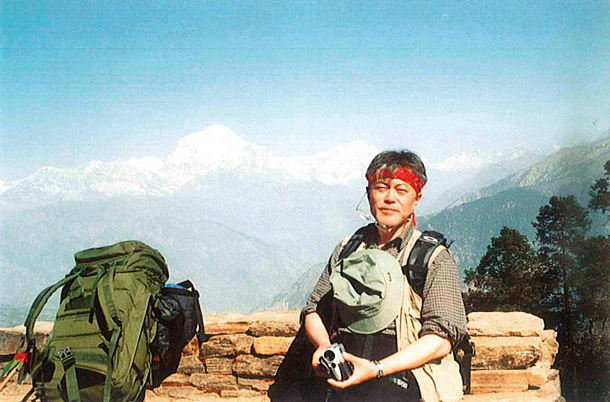Understanding a ‘good’ economy

President Moon Jae-in while trekking the Himalayas in 2004 after he resigned as senior presidential secretary for civil affairs for then-President Roh Moo-hyun. [JOONGANG ILBO]
Kim Hyun-chul, economic adviser for the president, recently explained the concept of “good” growth to reporters. Growth that generates or worsens inequality is considered bad, and growth that strengthens distribution to ease income and wealth disparities is good. The government will aim to solve various social challenges and problems while maintaining the growth pace near the end of the 2 percent range. His comment suggests that the new government accepts a growth of under 3 percent as the norm.
Kim, who was recruited to tutor and guide the president on economic policy, published a book titled “The Vision for a New Korea: an Embracing State” with nine other scholars. “Good growth” and “embracing government” will likely dominate the president’s policy.
Under the vision of Kim and the other scholars, the economic direction of the country will revolve around people, not enterprises, balanced growth and distribution, and be aimed to improve livelihood. Few would protest such a vision. But present and future economic conditions are too harsh to accommodate such idealism.
Korea’s growth potential has suffered from demographic weaknesses like an aging population and the low birth rate. Overseas trade fronts are less favorable due to heightened protectionist measures in the U.S. and China. Moon hopes that new venture industries, not the traditional factory sector, will lead the economy as a result of income growth. His policy is set on non-mainstream economics. Economists like Nobel-prize-awarded Joseph Stiglitz have championed the concept of shared prosperity and growth development based on social progress after the limits of neo-liberalism and globalism were underscored by the 2008 financial crisis.
Chang Ha-sung, the policy chief of the Blue House, declared that the age of fast growth has ended and that expecting a trickle-down effect from large manufacturers has become a delusion in his book. But there is no guarantee that increasing the incomes of low-income families could translate into bigger consumer spending and corporate investment.
If the government pursues a “good” economy, there is no need to set a state target on growth. The public will to work for a stronger economy will weaken. Korea would be doing away with the export- and large enterprise-driven growth model that fueled the economy for more than a half century. It must start a serious public debate on whether we should settle for under $30,000 per capita income and 2-percent range growth and whether that is enough to sustain the economy for the next century.
Korea’s potential growth rate has been pared to 2.8-2.9 percent. Tarja Halonen who served as Finnish president, champions an end to the “tyranny of GDP.” But our economy is not the same as Finland’s. The country has a population of 10 million and one of the world’s highest incomes. The government should not suddenly ditch the country’s growth legacy because of its new infatuation with gross happiness.
JoongAng Ilbo, July 15, Page 26
*The author is a senior editorial writer of the JoongAng Ilbo.
Hong Seung-il










with the Korea JoongAng Daily
To write comments, please log in to one of the accounts.
Standards Board Policy (0/250자)